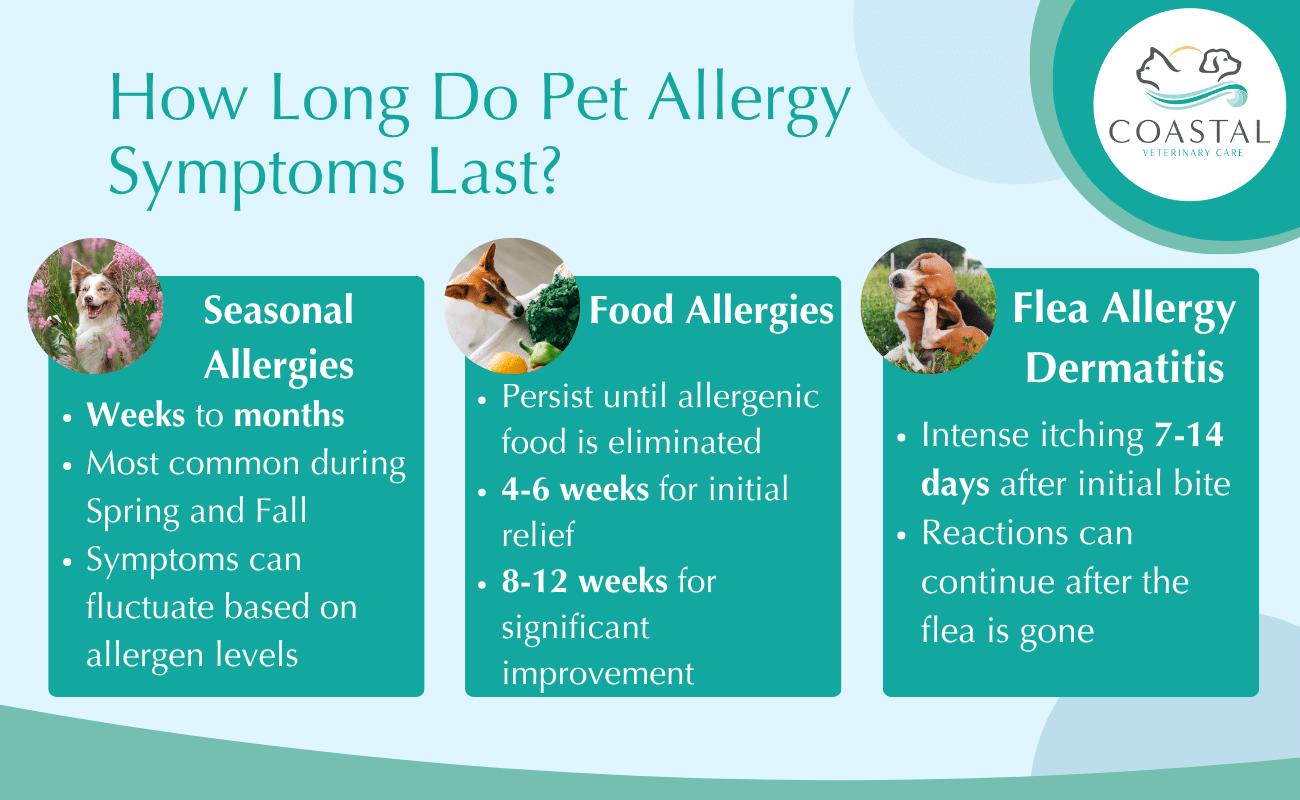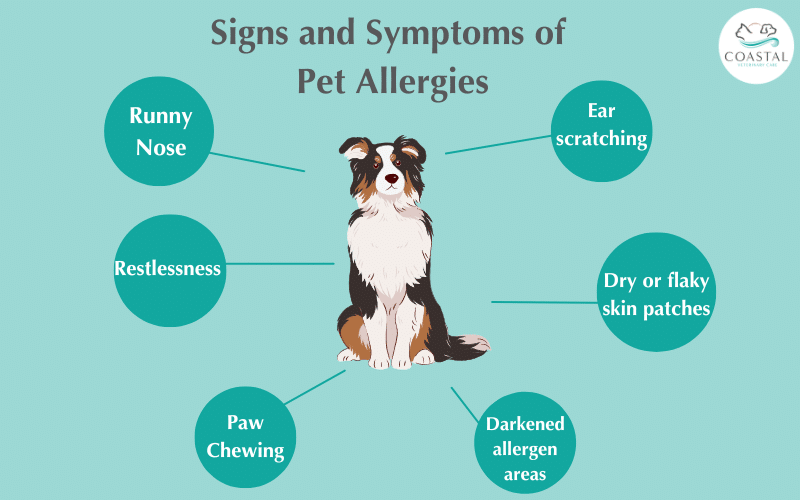Your Guide to Understanding Pet Allergies
At a Glance: Pet allergies are immune responses to environmental triggers, food allergens, or flea saliva that cause skin irritation and discomfort. Unfortunately, there is no cure for any allergic conditions, but they can be effectively managed with proper diagnosis and treatment options.
Just like humans, pets commonly experience allergic reactions, which can affect their daily comfort and well-being. Allergies are immune system responses that occur when our pets’ bodies overreact to ordinary environmental substances. Dogs and cats can develop responses to various allergens, including dust mites, certain foods, flea saliva, or even just seasonal allergies.
Three main types of allergies affect our furry friends:
-
- Environmental allergies (atopy) – caused by pollen, dust mites, and mold
- Food allergies – reactions to specific proteins in pet food
- Flea allergy dermatitis – severe reaction to flea saliva
These conditions cause itching, redness, and inflammation. Without proper care, they lead to scratching, skin infections, and behavior changes. Understanding these allergies is the first step toward relief.
This blog covers symptoms, diagnosis, and treatments for each allergy type. It includes practical ways to manage a pet’s environment, diet changes, and when to seek veterinary help. The goal is to help allergic pets live comfortably.
Common Types and Causes of Pet Allergies
Environmental Allergies
Just like humans, pets can develop allergies and allergic reactions to airborne allergens in their environment
Seasonal allergies:
-
- Affects many pets when pollen counts rise during spring and fall
- Trees, grasses, and weeds release tiny allergens
- Particles trigger allergic symptoms through:
- Inhalation
- Direct skin contact
Indoor allergens (year-round challenges):
-
- Dust mites in bedding and carpets
- Household cleaning products
- Air fresheners
Contact allergies:
-
- Certain fabrics
- Lawn treatments
- Grooming products
- Results in skin irritation at points of contact

Food Allergies
Food allergies in pets develop when their immune system mistakes certain food proteins as harmful substances. Common triggers include beef, dairy, chicken, eggs, and certain grains. Unlike food intolerances, which cause digestive issues, true food allergies typically show up as pet allergy symptoms and itching.
These allergies can develop at any age, even if your pet has eaten the same food for years. The timeline for allergic reactions varies; some pets show symptoms within hours of eating, while others may take days to display signs of an allergic response.
Flea Allergy Dermatitis
Flea allergy dermatitis (FAD) is a severe allergic reaction to flea saliva. When a flea bites an allergic pet, the saliva triggers an intense immune response, which causes severe itching and inflammation.
This condition is particularly problematic in warm, humid areas like Myrtle Beach, where fleas thrive year-round. Even a single flea bite can cause days of discomfort for sensitive pets, making consistent preventative measures especially important for pets with FAD.
Recognizing Allergy Signs, Symptoms, and Duration
Pet allergies manifest through distinct physical and behavioral changes that vary by allergy type. Understanding both the symptoms and their expected timeline helps in effective management and treatment, allowing pet owners to provide appropriate relief and prevent complications.

Common Symptoms Across All Allergy Types
Physical Signs:
-
- Skin inflammation with redness and dry, flaky patches
- Small bumps or rashes developing on irritated skin
- Patchy hair loss or thinning fur in frequently scratched areas
- Thickened or darkened skin in chronic, long-standing cases
Behavioral Indicators:
-
- Persistent scratching, biting, licking, and paw chewing
- Rubbing against furniture or carpeting to relieve itching
- Decreased activity, irritability, and disturbed sleep patterns
- Restlessness and apparent discomfort, especially after exposure to triggers
Specific Allergy Types and Their Characteristics
Environmental Allergies (Atopy)
-
- Runny nose, sneezing, and watery eyes
- Most affected areas: face, paws, belly, and ears
- Symptoms may worsen after outdoor activities or during certain weather conditions
Duration: Symptoms follow seasonal patterns with flare-ups typically in spring and fall when pollen counts are highest. With indoor allergens like dust mites or mold, pets may experience year-round symptoms if exposure continues without intervention.
Food Allergies
-
- Year-round skin issues (not seasonal) that don’t respond to antihistamines
- Often affects belly, base of tail, ears, and sometimes face
- May include digestive problems (vomiting, diarrhea, increased stool frequency)
- Occasional secondary symptoms like ear infections or anal gland issues
Duration: Symptoms persist as long as the allergen remains in the diet. Once eliminated, improvement begins within 4-6 weeks, though significant relief may take up to 8-12 weeks in some pets. Some sensitive animals may require lifelong dietary management.
Flea Allergy Dermatitis
-
- Intense itching concentrated at tail base, lower back and thighs
- Visible flea dirt (small black specks) and occasional adult fleas
- Hot spots (sudden areas of intense inflammation and moisture)
- Progressive spreading to new areas if untreated, including the neck and abdomen
Duration: Severe itching continues for 7-14 days after even a single bite, even if the flea is gone, highlighting the need for consistent preventative measures. Some hypersensitive pets may react severely for up to three weeks post-bite.
Complications and Recovery
The most commonly affected body parts across all allergy types include the face, ears (with redness and noticeable odor), paws, belly, and base of tail. Without proper treatment, allergies frequently lead to secondary bacterial or yeast infections that extend symptom duration and require separate treatment approaches.
Recovery Timeline: With appropriate management through allergen avoidance, medication, and immunotherapy, many pets experience significant symptom reduction within weeks, though complete resolution may take months for severe cases. Regular monitoring and adjustment of treatment plans may be necessary, especially for pets with multiple allergies or seasonal variations in symptoms.

Diagnosis and Treatment Options
Professional Diagnosis
When pet allergies are suspected, your veterinarian will conduct a thorough examination of your pet’s skin, coat, and allergy symptoms. This process typically starts with a detailed review of your pet’s medical history and immune response. The vet examines areas showing allergic reactions or inflammation and may perform skin scrapings or cytology tests to check for secondary infections.
Blood Tests
-
- Measures the immune system’s response to allergens
- Less invasive procedure
- Results can take several days
- Can be performed by your regular veterinarian
Intradermal Skin Testing
-
- Involves injecting small amounts of allergens under the skin
- Immediate allergic reaction observation
- Must be performed by a veterinary dermatologist
- More accurate than blood testing
- Requires mild sedation in some cases
During diagnosis, your vet will also work to rule out other conditions that can mimic pet allergy symptoms, such as parasites, hormonal issues, or autoimmune disorders. This might involve additional allergy testing based on your pet’s specific symptoms.
Treatment Approaches
Treatment for pet allergies typically involves multiple strategies working together. Medications can include antihistamines to reduce itching, anti-inflammatory drugs to reduce inflammation, and antibiotics if secondary infections are present. Some pets benefit from allergen immunotherapy (allergy shots) tailored to their specific allergens.

Diet modifications play a significant role, especially for food allergies. Your vet might recommend a limited-ingredient diet or prescription food to identify and avoid trigger ingredients. Following the diet plan strictly is important for success.
Environmental management focuses on reducing exposure to airborne allergens. This includes using special shampoos or wipes to remove pet allergens from your pet’s coat, changing air filters regularly, and keeping your pet’s bedding clean. Some pets benefit from omega-3 fatty acid supplements to support skin health. For pet owners with allergies themselves, reducing pet dander is equally important to managing human allergy sufferers in the household.
Prevention Strategies
Regular cleaning helps minimize allergen exposure. Vacuum frequently, especially in areas where your pet spends time. Wash your pet’s bedding weekly in hot water, and consider using allergen-proof covers for pet beds.
Managing Environmental Triggers
For environmental allergies, timing outdoor activities when pollen counts are lower can help. Wiping your pet’s paws and coat after outdoor activities removes allergens before they spread through your home. Using air purifiers with HEPA filters can reduce airborne allergens indoors.
Regular Grooming & Veterinary Care
Maintaining a consistent grooming schedule removes pet dander from your pet’s coat and helps you spot skin issues early. Work with your vet to develop a personalized prevention plan based on your pet’s specific allergies and triggers. For severe cases, your vet might recommend appropriate allergy medicine as part of a comprehensive treatment plan.

Next Steps in Pet Allergy Treatment and Management
While there’s no complete cure for pet allergies, you can help your furry friend live comfortably through proper treatment options and care. Regular monitoring of your pet’s immune system, skin, and behavior allows you to catch allergens early before they become more serious.
Contact your veterinarian if you notice persistent symptoms like scratching, hair loss, skin redness, or changes in behavior. Early intervention often leads to better outcomes and can prevent severe allergic reactions. Between vet visits, maintain a clean living space, follow recommended allergy medicine schedules, and watch for environmental allergies that might trigger reactions.
Regular monitoring of your pet can help catch allergens early:
-
- Persistent scratching or licking
- Hair loss or thinning fur
- Skin redness, irritation, or rashes
- Changes in behavior or energy levels
- Ear infections or excessive head shaking
Promptly contact your veterinarian if you notice:
-
- Symptoms persist for more than 2-3 days
- Severe skin irritation or open sores
- Significant hair loss
- Lethargy or refusal to eat
- Difficulty breathing
Between vet visits, maintain a clean living space, follow recommended allergy medicine schedules, and watch for environmental allergies that might trigger reactions.
Here at Coastal Veterinary Care in Myrtle Beach, our team follows protocols recommended by board-certified veterinary dermatologists. We’re ready to help develop a tailored treatment plan for your pet’s allergies that may include options like topical treatments and nasal spray for certain conditions or allergy shots for long-term management.
Choose Coastal Veterinary Care in Myrtle Beach, SC
At Coastal Veterinary Care, we can help you determine an appropriate veterinary schedule that best supports your pet’s needs. From planning regular routine visits to understanding what to look for to identify when your pet may need to be seen to evaluate a specific injury or illness, we are here to help you make sure your pet gets the best possible care. Contact us today to learn more about why we are a trusted choice among pet owners in the Myrtle Beach, SC, area or to schedule an appointment!
